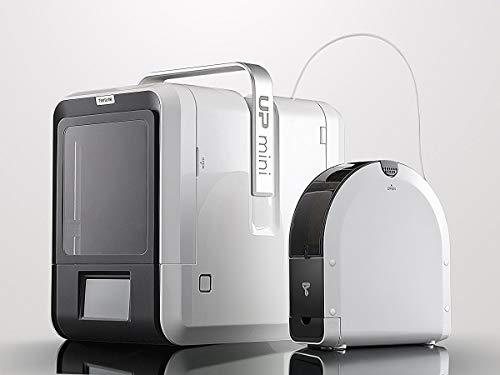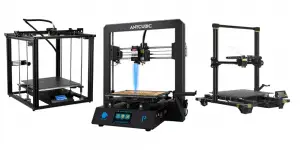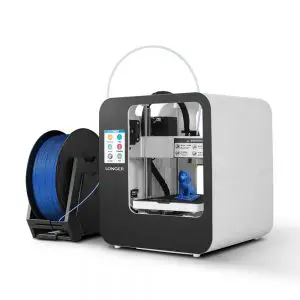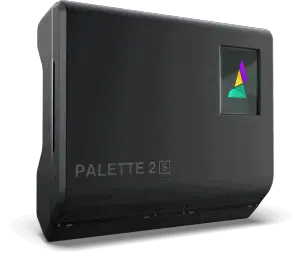If you’re in a hurry and just want to know what the best 3D printer for beginners is, then we recommend the Creality CR-10S as the best one.
Getting Started With 3D Printing
While 3D printing isn’t exactly new, it is becoming more commonplace as the technology advances and they become easier to use. The best 3D printer for absolute beginners will be easy to use right out of the box. On the other hand, some others offer stiff competition even though they require some assembly. You’ll also want a printer with easy to use software and comes with a knowledgable community that can assist you when customer support or the manufacturer’s website doesn’t help with what you’re trying to achieve. Outside of the software, there are some other features you should consider when buying your first 3D printer.
In this article we will review the following 3D printers for absolute beginners:





What To Look For In The Best 3D Printer For Beginners
Build Volume
When looking for the best starter 3D printer the build area should be one of the first things you see. Working with a small build area limits your ability to get creative. The cubic area for most printers ranges between four and nine inches cubed, but the more expensive options tend to give you a larger area to work with. You’ll also want to look at printers with an enclosed area.
Filament
PLA is the standard filament used in the majority of 3D printers. However, when looking for the best 3D printer for beginners, you’ll want one that can handle a large variety of building materials so your creativity and designs aren’t limited. ABS is a tougher filament used for objects you’d like to handle roughly and be able to drop. You might want to design a project with some shimmer and need a metal filament or some other exotic build material. At the very least, the 3D printer you choose should be able to handle PLA and ABS to give you the option of different products.
PLA offers low odor printing with less energy consumption. You can print things like food containers, candy wrappers, and prototype parts. ABS is for tougher objects like sports equipment and LEGO bricks. It also stinks and needs to be printed in a space with a lot of ventilation or with a printer that uses an enclosed build area. Burning plastic to print your projects gives off a variety of fumes that can aggravate allergies, asthma, or other respiratory conditions. It’s essential to choose a machine that works best in the environment you plan to place it in.
Layer Height & Resolution
The average layer height is around 100 microns which converts to about .1 mm. The thinner the layer height the better the resolution. You should also consider your extruder when taking into account the layer height. The average extruder also referred to as a nozzle or hot end is .40 mm in diameter and achieves high temperatures to extrude your specific filament. You’ll need one with consistent heating throughout your builds to achieve accurate layers without warping. The nozzle works in conjunction with the motors moving along the axes.
Build Speed
The faster the hot end moves while building your design, the faster your build will finish. However, some printers can’t handle the faster speeds and average the best prints at 60 mm per second unless specified differently. You can play around with the speed settings, but the filament you’re using affects the speed. Certain materials print much slower than others and certain printers print slower than others. You’d hope that with a slower build speed the resolution and finish on your projects would be outstanding. It’s best to play around with the settings to get the perfect build speed and accuracy as some printers will warp your layers at higher build speeds.
Calibration
Manual leveling has to be the most annoying factor of the 3D printing process, especially when you’re inexperienced. It gets easier the more you do it because you learn what to look for. The best feature to look for in a beginner’s 3D printer is for assisted leveling at least. You can use a sheet of paper between the nozzle and print bed at the five points to level the bed. Read the manual of whatever printer you get to be sure you’re adjusting the build plate correctly. You’ll also want to make sure the Y and Z axes are calibrated and unobstructed as you don’t want anything to interfere with the build.
Choosing The Best 3D Printer For Absolute Beginners
Here are the top contenders for starter 3D printers. They range in price and capabilities but they’re easy to use with room to learn and grow.
1. Makerbot Replicator+
- Build volume: 11.6 in x 7.6 in x 6.6 in
- Filament: PLA
- Layer Height: 100 microns
- Build Speed: 150 mm per second
- Calibration: Precision-factory leveling prior to shipment
The printer comes from the manufacturer ready to go with the calibration already set and the software allows you to access millions of free files to download for printing. Its high-resolution printing will yield a smooth design and finish. The printer only takes PLA filament and the bed isn’t heated. The extruder is easily swapped out. For the expensive price tag, the printer should be able to print with other filaments outside of PLA, but it’s an easy machine to learn with until you’re ready to experiment with more complex designs and materials.
Pros:
- Ready to print out of the box
- Tested for environmental safety
- Precise calibration is done by the manufacturer
- Easy swap extruder
- Millions of free files for download and printing
Cons:
- Really expensive
- Tough PLA extruder is only good for 3 rolls of filament
- Users report clunky interface with the touchscreen
- Difficulty calibrating and leveling the print bed if necessary for future adjustments
- Printing only optimized for PLA filament in this MakerBot printer
2. Tiertime UP Mini 2
Build volume: 4.7 in x 4.7 in x 4.7 in
Filament: Proprietary and third-party filaments accepted – PLA, ABS, ABS+, TPU, exotics
Layer Height: 150 microns
Build Speed: 200 mm per second maximum
Calibration: Software Assisted
Possibly the best 3D printer for kids with its enclosed build area, a door sensor and the ability to use the printer with the HEPA filter. It’s fairly quiet and prints with fine resolution. The ability to print with standard and exotic filaments make this printer fun to use for the creative mind. The software-assisted calibration can take some tinkering around to get right but the bed is heated and flexible.
Pros:
- HEPA and Carbon-activated filters
- Extensive customer support and social media groups for online community troubleshooting
- Enclosed build area
- Flexible print bed makes removing builds easier
Cons:
- Unable to print without a live internet connection
- Small build area
- Users report parts failure after only a few months
3. Creality CR-10S
Build volume: 11.8 in x 11.8 in x 15.7 in
Filament: Supports PLA, ABS, exotic and up 10 varieties of build materials
Layer Height: 100 microns
Build Speed: 80 mm per second
Calibration: Assisted manual leveling
This printer comes with a little assembly involved. Once you get it put together and let the bed heat up, it’s easy to use after making sure the settings are calibrated to your build. This may not be the best 3D printer for kids but it lets older ones learn as they go so long as they’re careful and trusted to tinker with the settings and software. The removable glass bed is great for filaments that need higher print bed temperatures.
Pros:
- Massive build area
- Inexpensive and easy to assemble
- Removable glass print bed
- Easy to use
Cons:
- Difficulty leveling the bed
- Print bed takes a long time to heat up
- Takes up a lot of space
- Prints don’t always stick to the bed
4. Flashforge Finder
Build volume: 5.5 in x 5.5 in x 5.5 in
Filament: PLA
Layer Height: 100 microns
Build Speed: 40 to 200 mm per second
Calibration: Assisted manual leveling
This affordable printer is great to use right out of the box coming fully assembled. It has a small build area and is slightly clunky to use with non-proprietary PLA filaments. The assisted manual leveling can take some getting used to. The Wi-Fi file transfer option is a convenient feature. Overall, this is a contender for the best 3D printer for kids but doesn’t give much room for more ambitious designs or larger scaled builds. If you’d want to print with ABS or any other popular filaments, you’ll have to find a different printer.
Pros:
- Easy to use
- Quiet printing
- large and clear touchscreen with Wi-Fi file transmission
- Enclosed build area
Cons:
- Non-heated bed
- Only prints with PLA
- Small build area
- Supports can be difficult to remove
5. Monoprice Select Mini V2
Build volume: 4.7 in x 4.7 in x 4.7 in
Filament: PLA, ABS, HIPS, PVA, TPU
Layer Height: 100 microns
Build Speed: 55 mm per second
Calibration: manual, but is supposed to come calibrated from the factory
This compact printer comes fully assembled and calibrated from the factory, but some have reported that it still needs some tinkering prior to the first build. The print bed takes some time to heat up and the build area is quite small. Its open-source software capability and ability to print with a variety of filaments make it a great choice for the best starter 3D printer for those who don’t mind learning a few tips and tricks for the machine and software along the way.
Pros:
- Fully assembled
- Open-source software capability
- Inexpensive
- Heated print bed
Cons:
- Inconsistent hot end temperature during builds
- Manual calibration makes it tricky to level
- Print bed heats slowly and the build speed is slow
- Small build area
Which Is The Best Beginner 3D Printer?
The Creality CR-10S with its massive build area and open-source filament capabilities make it the best beginner 3D printer. It is easy to use and offers a learning curve for growth with beginning users. The build speed is great for the space it has to work with and it’s easy to assemble. Yes, the printer will take some tinkering to level it and get it calibrated to your design’s specific setting, but there’s a large online community to assist you in troubleshooting any issues you may have. Becoming a member of the 3D printing community means giving yourself some room to learn and make mistakes. There will be failed builds, gnarly software and maybe some print bed warping along the way, but learning how to adjust and fix these common issues allows you to move beyond the best 3D printer for beginners. For now, the best bang for your buck is the Creality CR-10S if you’re looking for a 3D printer for beginners.
Last update on 2025-04-19 / Affiliate links / Images from Amazon Product Advertising API









